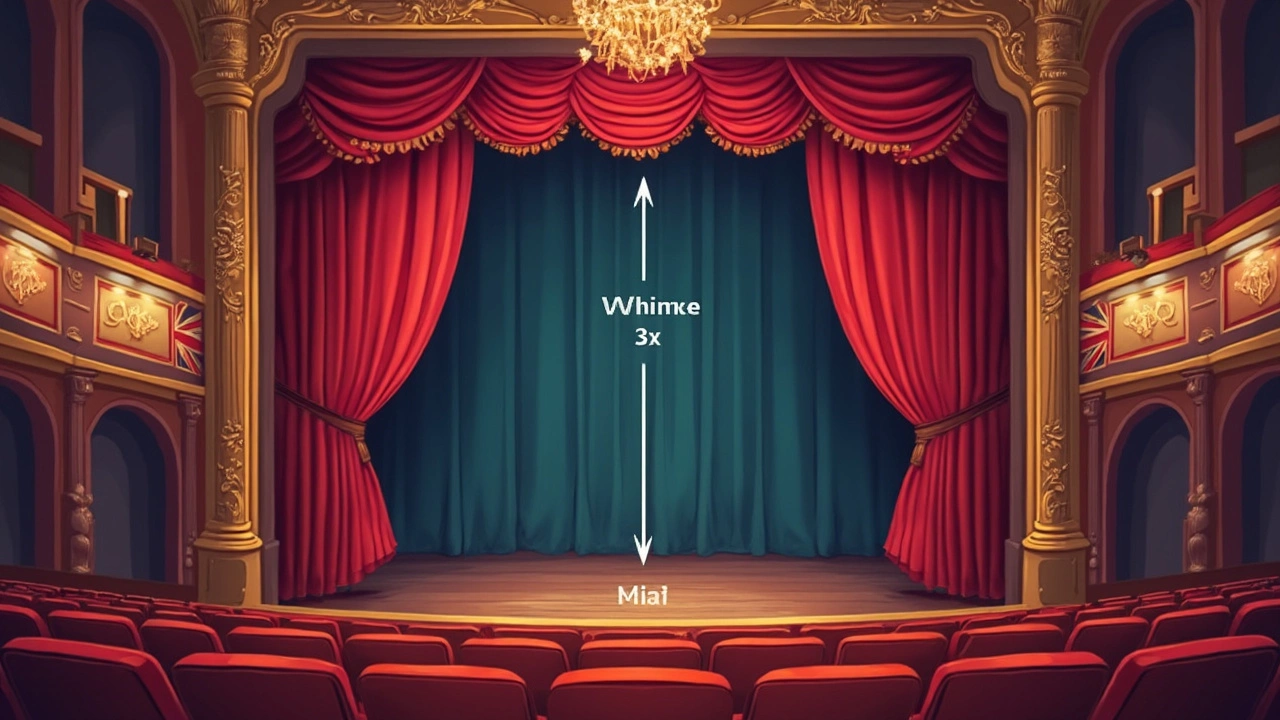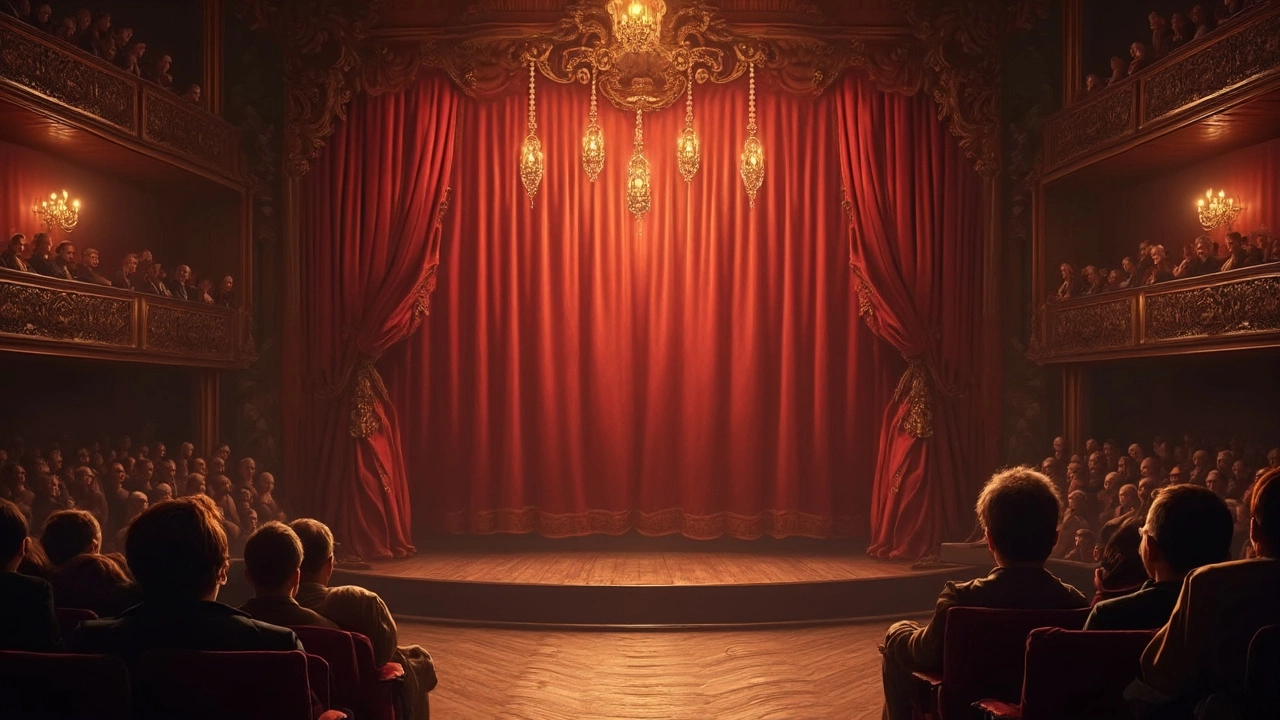You ever sat down in a darkened theatre, your popcorn balanced on your lap, and found yourself staring up at that grand, imposing piece of fabric separating you from the magic happening behind it? Most people never give it a second thought, but that curtain right at the edge of the stage isn’t just a piece of décor—it’s a hardworking part of every performance. Funny thing is, most stage newbies and even a fair chunk of regular theatre-goers can’t actually name it. Ready to peel back the fabric and see what it’s called, what it does, and how it fits into the whole dazzling show? Buckle up, because curtains—the unsung heroes of stagecraft—have a story worth telling.
The Front Curtain: The Star That’s Right Under Your Nose
The curtain nearest to the audience is called the front curtain, but you’ll also hear it called the grand drape, house curtain, act curtain, or even the main rag for those who’ve spent way too many late nights backstage. This isn’t just tradition—each nickname hints at how theatres have evolved over centuries. Here’s the headline, though: that front curtain isn’t just theater jewelry. Its job is absolutely critical. It serves as both a literal and symbolic boundary between real life (where you’re munching those maltesers) and the heightened reality of the stage, which is why front curtains are grand, lush, and impossible to miss.
Let’s get concrete: theatres usually hang this curtain just behind the proscenium arch. That’s the big, decorative frame shaping the opening you watch the play through. When the house lights dim and the curtain rises or parts, it’s like opening a storybook. Melbourne’s own Princess Theatre still uses an ornate red velvet main drape that reportedly weighs over 200 kilograms—pulling it is an upper-body workout worthy of the gym.
The grand drape also acts as a shield. It hides the stage as sets and lighting get prepped. If something unexpected happens (like when that black cat infamously wandered onstage at the State Theatre in 1998), the curtain comes crashing down, blocking out the mayhem.
Not All Curtains Are Created Equal: Exploring Curtain Varieties
You’ll find more going on behind the grand drape than you might expect. Curtains in a theatre are about as varied as the acts themselves. Each has a purpose, and yes, it can get a bit technical, but it’s also totally fascinating. Here’s a quick cheat sheet you could flash around backstage to impress your mates:
- Front Curtain (Main Drape): Sits closest to the audience. Usually the fanciest and thickest, hiding the stage during pre-performance chaos.
- Tormentor Curtains: Narrow curtains just inside the proscenium, helping mask backstage equipment and provide a tidy frame for the stage.
- Border Curtains: Horizontal drapes that hang above the stage, hiding lighting and rigging. Sometimes called teasers.
- Legs: Tall, skinny curtains stretching up and down just inside the wings. They hide actors’ entrances and anything lurking backstage.
- Backdrops and Cycloramas: Large cloths at the rear for scene setting or cool lighting effects.
- Scrims: Special thin curtains that look solid or transparent depending on the lighting—tricky but magical.
But back to our main hero—the one closest to the audience. Sometimes, especially in smaller venues around Australia, you might spot a simple traveler curtain instead of a lavish velvet drape. Travelers open from the center and slide across rails, offering a nifty, modern alternative. In old-school theatres with more pizzazz (think Her Majesty’s Theatre in Ballarat), you’ll spot main curtains with gold tassels and hand-painted crests straight out of a Victorian-era drama.

The Mechanics Behind the Magic
Pushing back the curtain (pun absolutely intended), the technical stuff is where it gets juicy. The grand drape is not just thrown up on a rod like your granny’s living room. There are different opening methods, and each style changes the drama of the reveal. Here are a few you’ll find in theatres across Australia and internationally:
- Guillotine (Up and Down): The curtain lifts straight up, either quickly or with drama as the show demands.
- Traveler (Side-to-Side): The curtain splits in the middle and glides open left and right—this one’s loved for musicals and quick set changes.
- Austrian (Accordion-Style): Bunched up with vertical cords and gathered like a posh prom dress. You get a swooping, romantic effect, perfect for old-school spectacle.
- Tableau: Two precisely controlled ropes pull the front curtain up diagonally into symmetrical swoops—if you’ve ever seen this, you won’t forget it. Super classic.
Pros in the business love tweaking the mechanics to fit each show. For a fast-moving comedy, a quick guillotine drop means no one’s left waiting. For opening galas, that Austrian pull gets audiences gasping at the sheer luxury.
Worth mentioning: some of the older theatres rely on stagehands to physically haul the curtains by hand. In really high-stakes theatres like the Victorian Arts Centre, those curtains are on state-of-the-art counterweight systems and electrically controlled winches. More safety, more precision, way less chance of embarrassing mishaps (though, trust me, they still happen).
| Theatre | Main Curtain Type | Weight (Approx.) |
|---|---|---|
| Princess Theatre, Melbourne | Velvet, Guillotine | 220 kg |
| Her Majesty’s Theatre, Ballarat | Velvet, Austrian | 200 kg |
| Australian Ballet Centre | Traveler, Velour | 120 kg |
| Sydney Opera House, Drama Theatre | Traveler, Velour | 105 kg |
I’ll bet you’re picturing some red-faced stagehand in overalls right now, tugging that 220 kg of velvet. And you wouldn’t be wrong (they’re probably hitting their third flat white of the morning).
Fun Facts, Odd Traditions, and Theatre Magic
Theatres are crawling with quirks, superstitions, and delightful oddities when it comes to their curtains. Most folks know about the ‘ghost light’ left onstage overnight, but the main curtain is part of the ritual, too. At the Theatre Royal on Russell Street before it closed, staff insisted the grand drape stay shut overnight to keep the spirits from wandering. Up in Sydney, actors still touch the front curtain for luck before a first run—fate apparently prefers velvet.
The style and material of the closest curtain also signal a theatre’s age and personality. In classic venues, you’ll see gold fringe, heavy tassels, and velvet so thick it dampens all sound when closed. In more modern, multipurpose spaces (think the Arts Centre Melbourne’s Playhouse), the curtain is often lighter, less fussy, and built for fast action—shows cycle through at lightning pace, so those curtains need to move as quickly as the cast.
Want to impress your theatre nerd friends? Here’s one for the trivia list: while the grand drape is almost always closest to the audience, in rare cases (like immersive theatre or certain magic shows), the closest fabric might actually be a scrim or a stage drop placed in front of the proscenium just for effect—stirring up mystery before the main event.
Historically, back in Elizabethan times, there was actually no curtain at all—performances simply started at a signal (like a trumpet) and the reveal was all about actor entrances. Curtains came much later, mid-18th century in Europe, as audiences craved more suspense and surprise. Suddenly, the curtain-drop became a dramatic punctuation mark, not just a practical fix.

Spotting the Right Curtain: What to Look for Next Time
Next time you head to the theatre, take a closer look up front. The closest curtain will probably be rich, textured, and absolutely impossible to ignore—that’s the main drape. It’s there to get you anticipating, keep secrets, and set the mood. If you see a second, inner curtain moving during transitions, you’re probably catching glimpses of borders or legs—they’re not designed to dazzle, just to tidy up the edges and keep the magical backstage stuff hidden.
For curious minds: if you ever get to peek backstage on a tour, check out the track system or the counterweights hanging at the sides. Each system was probably customized for that venue’s quirks. Melbourne’s theatres, old and new, show the whole range—from elegant, historic curtain systems running on pure muscle, to sleek, hydraulic setups with digital controllers. Even the stage hands will admit there’s a real beauty in the craft.
If you’re dabbling in amateur productions or planning a show at your local community hall, don’t sweat it. Just find a heavy, dark-colored fabric that hangs well and slides easily, and borrow the magic of the pros. Velour is always a popular choice, and you can achieve a dramatic effect even on a shoestring budget with some creative lighting and a few tassels from a craft store.
Here’s a tip for the DIYers: if you need your curtain to be blackout quality, double up your fabric. Light bleed ruins illusions faster than a badly timed phone ring. If you’re making a traveler curtain, opt for strong track hardware—household rails won’t stand up to repeated use. Quality helps the illusion stay fresh night after night.
There’s something quietly heroic about that curtain closest to the audience. It tells you, "Get ready. Things are about to get interesting." And whether you’re sitting row A or hauling ropes in the wings, knowing what’s behind that velvet makes the whole night feel just a bit more magical.


